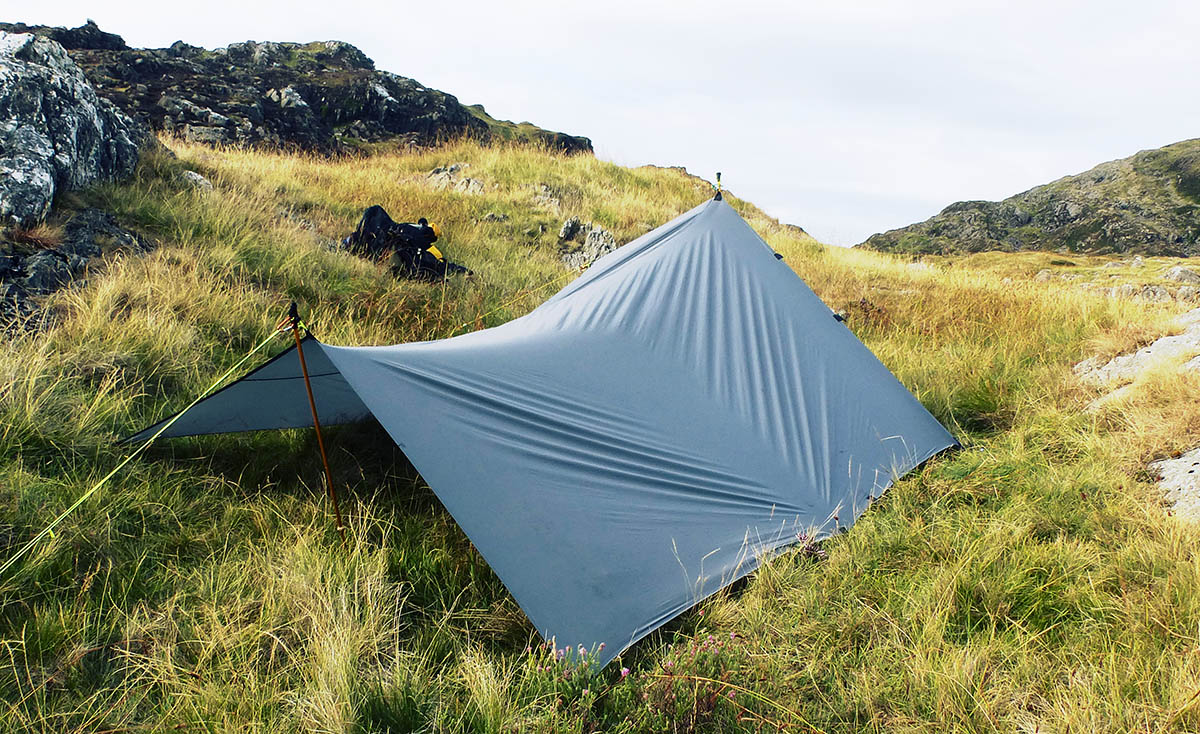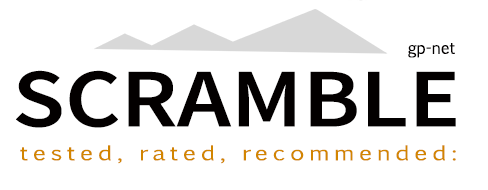Gimme Shelter: Reasons To Go Modular, Parts 1, 2, 3
This is a companion post to all of our shelter reviews, which follow the rationale outlined below.
Products Covered
| Product (Type) | Review |
| Macpac Bush Cocoon (Hooped Bivvy) | Yes (8.3) |
| Alpkit Hunka (Bivvy Bag) | Yes (8.1) |
| Scramble G-Mod 35, G-Mod 38 (UL Solo Tarps) | Yes (8.8) |
| Scramble G-Mod 55 (Deluxe Solo / UL 2-Person Tarp) | Yes (8.6) |
Contents
- Part 1: How Did We Get Here?
- Part 2: Low Hanging Fruit Vs. Fallen Angels
- Part 3: What's Your Trip?
- Summary
Part 1: How Did We Get Here?
Under Cover
These three images have something in common - there's no natural cover under which to shelter, whether from the sun, rain, hail or snow, or from strong gales. Having a small lightweight tarp means you can quickly setup a shelter, take a load off and actually enjoy a well earned rest no matter where you are. Without one, you'll likely either plod on waiting for that ideal, convenient landscape that never arrives, or sit down, be miserable for a while and curse the conditions and/or your bad luck. You could set up your tent, but really? For a lunch break?
The benefit of a traditional 'bivvy bag + tarp' is that the tarp on its own can be used as a temporary shelter when you're desperate for a break and there's no natural cover. Whether it's the burning sun, relentless rain or buffeting gales you need a rest from (to cook up a brew or just pass out for a while) a tarp is the ideal accompaniment for short stops on long treks. A tent is just too much hassle for a temporary shelter and is not the ideal setup when all you really want is a wind-block or a little overhead cover. Also, you may be in a place not condusive to hosting a tent; tarps are far more flexible and unphased by gradient, ledges, or ground conditions. Having the option to take a break pretty much anywhere in all conditions is now something I won't forego (for its morale boosting effect alone).
From Studio Apartment To One Bedroom Flat
Once you carry a lightweight tarp, you've essentially gone from living in a studio apartment to a one bedroom flat, i.e. you've now got a sleeping compartment and a (partially al fresco) living room. Since you're now only really sleeping in the "tent" (the bedroom), and you're cooking, changing, planning routes etc. under the tarp (the living room) you no longer need such expansive sleeping quarters. Additionally, you can now pack and unpack your tent and all your gear while sheltered from heavy rain, hail and snow. That's a major plus.
 Beefing up the bivvy and slimming down the tarp
Beefing up the bivvy and slimming down the tarp
There are two sensible ways to proceed from here. Either you go with a bivvy bag and a decent sized lightweight tarp, or you beef up the bivvy (i.e. go with a hooped bivvy) and slim down the tarp. The former is lighter but offers less protection, the latter provides complete all-round protection but is heavier. We prefer the latter, but use both depending on the scenario. Before we get into that, we first need to make a distinction between two types of tarp user.
Part 2: Low Hanging Fruit vs. Fallen Angels
Once you decide to make the switch and adopt a modular approach, and you've found an appropriate bivvy, hooped or otherwise (see below), the hunt for the ideal ultralight tarp begins and something soon becomes apparent:
Most solo tarp designs seem to be a hedged bet, in that they are trying to appeal to both hammock and bivvy users at the same time. However, these two users have very different requirements: A hammock user needs trees, is elevated and generally prone and requires full horizontal coverage; whereas a ground-based tarp and bivvy user requires poles, can easily sit upright and, when sleeping, already has waterproof coverage for practically their entire body in the form of a bivvy. So, what they want from a tarp is protection from wind and rain when sitting and some protection, say for their torso upwards in the case of a bivvy bag user, from high winds and sideways precipitation when sleeping.
So a hammock user wants a long tarp and may get away with one that isn't that wide (if you're around trees you'll likely get some additional cover and breaks from the wind). But a bivvy user requires the opposite, they don't need all that length, but instead will likely require more width, since they're generally more exposed and need more lateral protection.
What a difference a foot makes
When it comes to ultralight solo tarps, what's interesting is that just a small shift from the rectangular toward the square can make a very big difference. 140 x 240cm = just under 3.4 sqm, 170 x 200 = 3.4 sqm. But that extra foot of width has a profound effect (and if you don't believe me, we dusted off our Pythagoras just to make a point).
Trying to please two distinctly different users with one product often results in fuzzy compromise and dysfunctional design choices. We couldn't find any ultralight tarps that fitted our requirements. So we made our own.
Part 3: What's Your Trip?
Long distance trekking: cool to sub zero conditions
For any long distance treks in cool to sub zero conditions we use the hooped bivvy + micro solo tarp setup. The hooped bivvy provides single-skinned, robust all-round protection from biting insects and tempestuous weather alike, with a minimal footprint (i.e. it can be used on very awkward terrain, on ledges, in very high winds, on mountain peaks etc.) and the tarp provides the aforementioned porch and quick shelter so that short breaks in harsh conditions can be restful, not stressful. It also completely solves the condensation issue that most people complain about when it comes to single skinned shelters, as one is able to vent the bivvy through the insect mesh (door ajar), assuming your hooped bivvy is well designed.
We recommend:
 Scramble's G-Mod 35 during the 2018 Winter Kit Test
Scramble's G-Mod 35 during the 2018 Winter Kit Test
Long distance trekking: warm to hot conditions
For long duration treks where nighttime temperatures are above +5°C in conditions equivalent to UK late spring through to early autumn, then we like the bivvy bag + tarp setup. When using only a bivvy bag we prefer a larger tarp; it doesn't add much additional weight, yet it allows for 1 or 2 sides to be completely sealed to the ground, and this added protection makes for a more relaxed overall experience on long duration treks..
Note: Most biting insects don't fair well in strong winds, but can be annoying as f*** in less stormy conditions. I always take a mosquito net when using a bivvy bag (maybe it's just me but I hate having my face eaten when I'm trying to sleep).
Here we recommend:
 Beefing up the tarp for the ground-based bivvy bag user: Scramble's Deluxe G-Mod 55 (in production)
Beefing up the tarp for the ground-based bivvy bag user: Scramble's Deluxe G-Mod 55 (in production)
The G-Mod 55 (which, all going well, will be available in September 2018) is designed to work with two poles (one short, one long) in a hybrid A-Frame / Lean-To configuration with 3 guylines and between 6 and 8 pegs.
Summary
So, to sum up. by modularising the tent, we get a protective shelter to get through the night and an indispensable quick shelter for short breaks in poor conditions during the day. If you're after UL bragging rights, it's hard to beat some of the insanely ultralight tents currently available, but if you spend many days, weeks, even months trekking off the beaten path, spending nights on exposed peaks and rigdes or lodged into one of mother nature's nooks or crannies, the sheer flexibility of a modular shelter for Scramble at least, is one for the long haul.
Last Updated: 24/08/18













